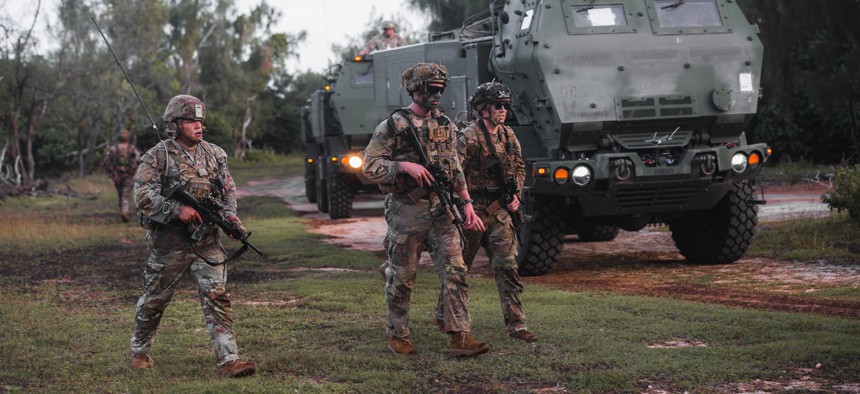
Soldiers with the U.S. Army's 25th Infantry Division escort four HIMARS vehicles of the 17th Field Artillery Brigade to their firing positions at Andersen Air Force Base, Guam, Sept. 26, 2022. Maj. Jonathon Daniell
Amid Pentagon Focus On China, Indo-Pacific Command Says It Has $3.5B Budget Shortfall
This “unfunded list” comes on top of the $9.1 billion the Pentagon requested for “Pacific deterrence” in its 2024 spending proposal.
The U.S. military has made no secret in recent years that countering China in the Pacific is top priority. Despite that, the U.S. Indo-Pacific Command submitted to Congress a list of 30 important projects totaling $3.5 billion that did not make it into the Pentagon’s $842 billion fiscal 2024 budget request.
The list includes funding for high-profile projects, including defending Guam from Chinese or North Korean ballistic, hypersonic, and cruise missiles. It also includes upgrades to missile interceptors, long-range artillery, space sensor, and offensive cyber effects.
These requests come on top of the $9.1 billion the Pentagon asked Congress to approve for “Pacific deterrence” in its week-old spending proposal. Those funds would go toward “critical investments including resilient and distributed air basing, new missile warning and tracking architecture, construction to enable enhanced posture, funding for defense of Guam and Hawaii, and multinational information sharing, training, and experimentation.”
But items listed on the unfunded priority list go beyond weapons and technology; they also include military exercises to “better familiarize our forces with the challenges associated with” operating in the Pacific.
“This is not new golf courses in Hawaii…but this is hardcore, combat, warfighting networking stuff,” said Bradley Bowman, senior director of the Center on Military and Political Power at the Foundation for Defense of Democracies, a hawkish Washington think tank.
“It's defending Guam from missile attack, it's hardening cyber network defenses, it's missile warning and tracking, it's space sensors, it's undersea targeting, it's resilient warfighting architecture, it's a joint fires network, it's missiles,” Bowman said. “These are exactly the things we need to make defense planners in Beijing think twice before they launch unprovoked aggression against Taiwan.”
Bowman questioned why the money for such important projects was not included in the Pentagon’s budget request. “What explains a $3.5-billion unfunded priority list that consists of such fundamental combat capabilities?” he said.
The unfunded list includes $147 million to help defend Guam from missiles. The list does not specify exactly how that money would be spent. Last week, the Missile Defense Agency asked Congress to approve $801 million to boost missile defense on the wester-Pacific U.S. territory.
“Current forces are capable of defending Guam against today's North Korean ballistic missile threats,” Michele Atkinson, Missile Defense Agency operations director, told reporters during a briefing last week. “However, the regional threat to Guam, including those from [China], continues to rapidly evolve.”
Other items on the list:
- $493 million to accelerate “development of precision strike stand-off weapons for attacking long range, medium range, and tactical targets.”
- $357 million for the SM-6 Block 1B interceptor to increase “capability for ground-based and naval long-range weapons for extended range to target enemy anti-surface warfare capability. This capability is foundational to provide combat formations with precision-strike capabilities that are operationally decentralized and geographically distributed in theater.”
- $275 million for “the next generation of national defense space architecture to enable U.S. military operations and responses to emerging multi-domain threats and adversaries.”
- $151 million for the Precision Strike Missile.
It also includes $511 million for transportation and support “to quickly mass forces multiple times a year as part of a persistent, synchronized set of operations, activities, and investments in the western Pacific and Indian Oceans.”
There’s an additional $70 million for joint training.
“You can have the best weapons in the world, you can have the best networks in the world, but if you don't have the training [and] exercises and the know how, among the people operating those weapons and systems, knitting it all together, it's not going to be as effective as it could be,” Bowman said. “And that's where the exercises and the training ranges come into play.”
Overseas exercises and training tend to get the short straw in the budget requests because there is no Congressional constituency for them.
“A lot of this stuff is essential to deterring aggression and defeating aggression if it happens,” Bowman said. “But because it's happening over there, and it's not necessarily stationed in a district or state, or it's not necessarily being built in a district or state, because it's something not necessarily related to a piece of equipment, then there's less of a political incentive for people to advocate for it.”
Sen. Elizabeth Warren, D-Mass., has led a bipartisan effort to stop the practice of commanders and the heads of each service from submitting these lists, arguing they are de facto addendums to the budget requests. The lawmakers have argued that if the projects are of such priority, they should be part of the budget submissions. Military officials, particularly those in charge of regional commands, say the lists are valuable because it allows them to respond to urgent threats.
“I would call in the Pentagon and say: ‘I want to go through every item on this list and I want to hear your argument, why you did not put this in the fiscal year 2024 budget request,’” Bowman said. “If the Pentagon cannot provide a persuasive answer, then it seems to me among the highest priorities in Congress for this session should be fixing those shortcomings, authorizing and appropriating the items on the unfunded list.”
NEXT STORY: Lawmakers Blast TikTok CEO Over Data Privacy
